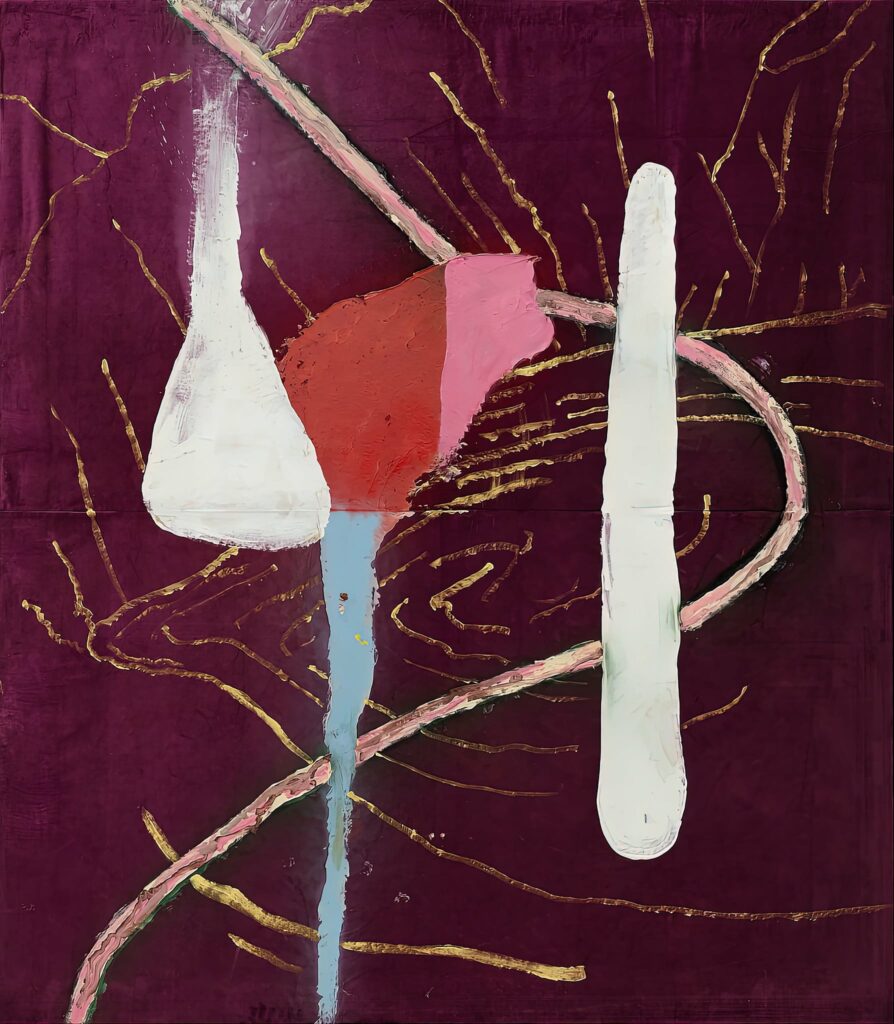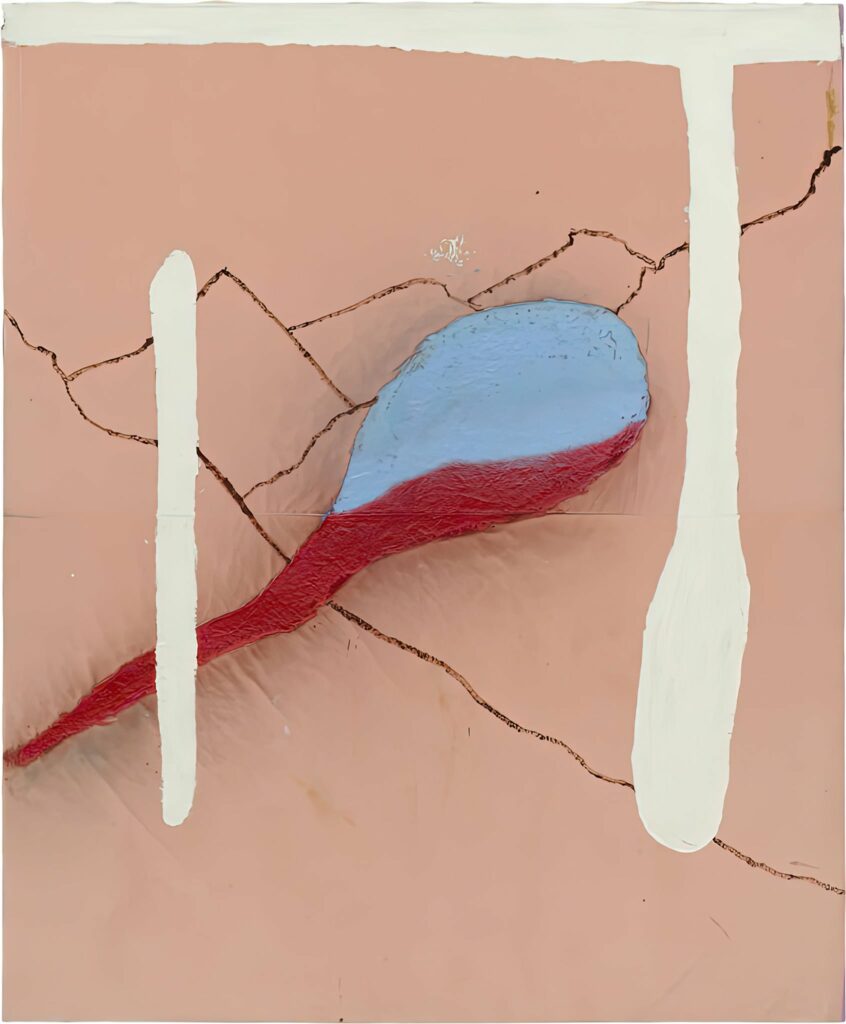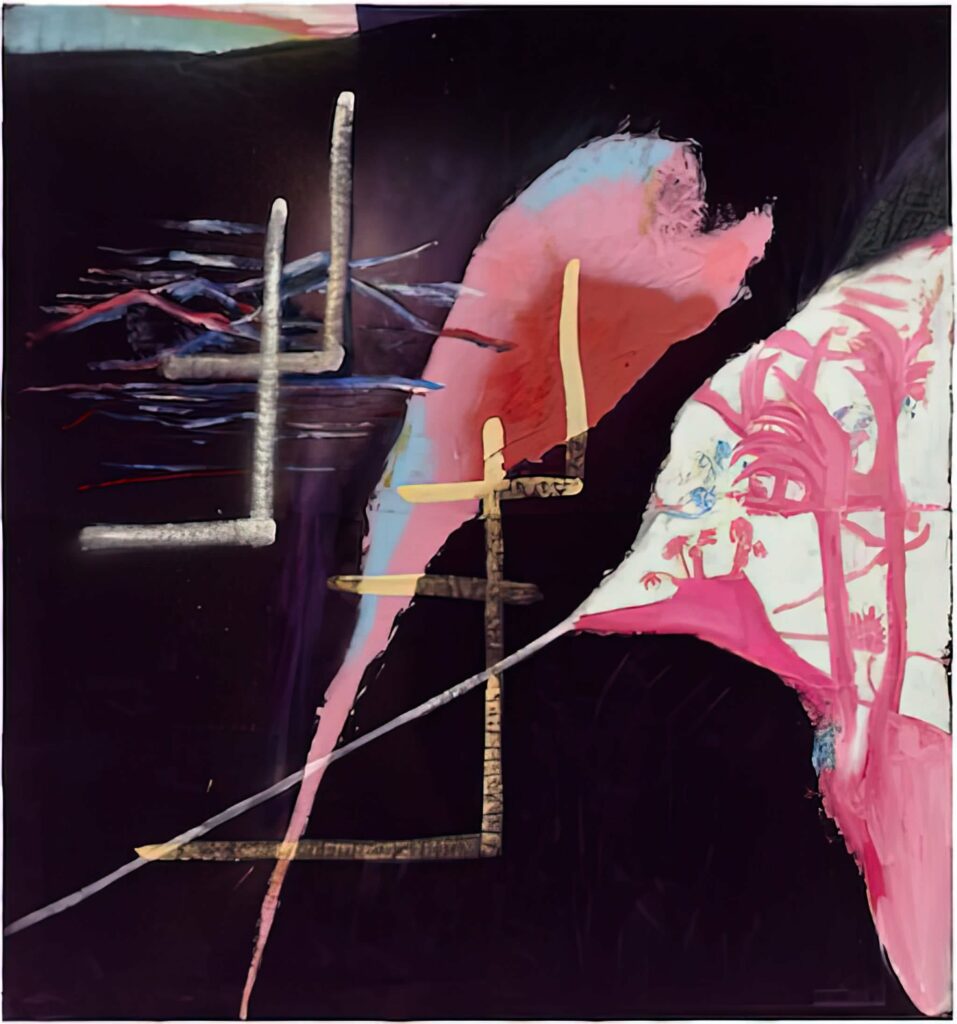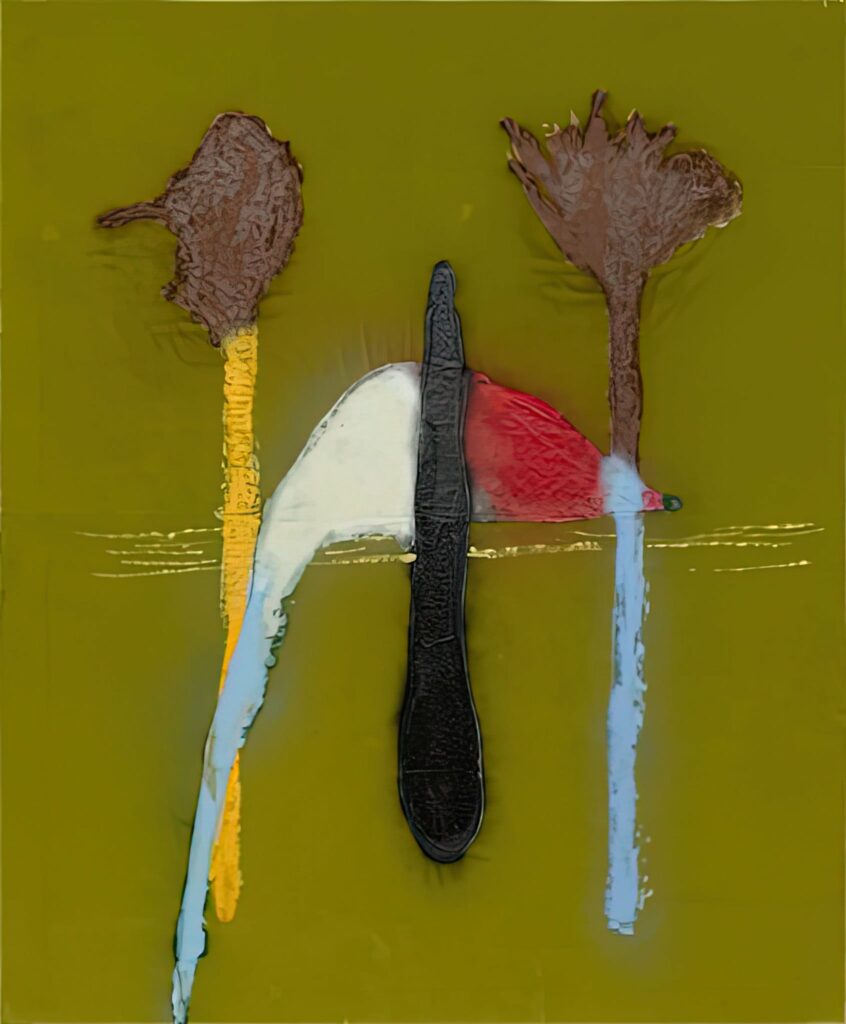An Analysis of the Artist’s Latest Work: PREDOMINATELY NATURAL FORMS, MEXICO, 2022
As the show’s title suggests, nature’s innate forms are the starting point for Julian Schnabel. Not spoken as such but made visually obvious in the work is that Julian so too abides by Picasso’s axiom, “I paint objects as I think them, not as I see them.” And that unstated tenet, on a fundamental level, for Julian, is observing the world in a quantum mechanical way—pictorial descriptions of nature on the subatomic scale. In other words, painting—with the naked eye—the invisible.

Quantum Science examines how everything in the universe is connected with everything else and does so mostly through investigations of higher, albeit smaller, subatomic particle dimensions (or multi-dimensions) that exist (purportedly) beyond our sensory faculties. Quantum physicists attempt to prove true the sort of far-out thinking that if you will it, it will be. The materialization of positive thinking, squared. Scientists have already proved that photons can change from particle into wave and back again. Pardon the parlance, but as they say on the street: crazy-ass, mind-bending shit for sure. Crazier still, if not entirely baffling, is that photons, and now we know other atomic particles as well, can be in two places at the same time, a phenomenon called Quantum Superposition. Simply put, each particle in the universe is also a wave, and waves, by their very nature, occupy multiple places in space at once. Surfers, like Julian Schnabel, intuit this. They know full well waves surfed today were formed elsewhere days ago. The wave itself, however, is riding (existing between) past and present concurrently. Art, in much the same way, has always been a portal between past and present time, a multi-dimensional window filled with transferential effects like powers which take us out of being trapped by our own bodies and into unexpected and at times unimaginable idea-worlds. With his latest collection, metaphysical constructs all, Julian Schnabel proffers sensuous access into the magic of quantum superposition while simultaneously magnifying the mysteries of nature’s natural forms in bold, exquisite, and fluid renderings.
Recently unveiled at Vito Schnabel Gallery, Tribeca, New York City, the four large-scale paintings, (1) Natural Forms on the Other Side of the Sierra Madres, (2) Natural Forms Near the Fountain of Youth, (3) Natural Forms Dancing at the Beach, (4) Natural Forms Before the Sun Comes up in Samba’s Boat, are not instantly recognizable representations of a specific place from a site-specific vantage point south of the American border. They are the physical manifestations brought about from Julian’s past and current experiences of place and of memory’s lingering sensations—and desire—of place. These four works act as conveyance—from his mind to yours—into pulsating fields of originative energy forging ancient vibrations along with hypnotic resonance; paintings rendered not analytically, or logically but conveyed non-linearly, multi-dimensionally, in some sense quantumly, creative invention which provokes a shift greater than the putative paradigm type–a shift of physics, maybe, where limitations, rules, and edicts deliquesce leaving the once-marooned mind new land, the freedom to reconstellate, to roam. Imagine a contrast at least as stark as America to Mexico, where boundless possibilities await….we’re talking orders of magnitude more profound.
Natural Forms Near The Fountain of Youth is imbued with meaning, myth, and coincidence. The painting’s instant appeal and prominence derive from the rich background and powerful purple velvet. The Phoenicians were the first to manufacture purple and did so by harvesting murex snails for their mucus. The ancient Greek historian, Herodotus, dubbed the Phoenicians the Purple People because the dye so stained the skin of those who made it. Interestingly enough, it was also Herodotus in the 5th century BC who first made mention of a ‘mystical spring’ to which Schnabel’s painting alludes.
Extremely expensive to produce, purple was always associated with royalty. From Mesopotamian Kings to modern-day British Queens, purple was revered, even outlawed to wear if not of royal blood. Its symbolism runs deep in most major religions. In the Catholic Church, it is associated with Christ’s death on the cross; purple carries the power of redemption through God in Judaism. The Hindus equate purple as a sign of peace, and in Buddhism, a subject Julian has often hinted at through his depictions of the Buddha, purple and mysticism go hand-in-hand. On that note, there can be no doubt that Julian Schnabel believes in the spiritual apprehension of truths existing beyond the intellect. Beyond ocular proof. As the other paintings also suggest, Natural Forms Near The Fountain of Youth is, in its physical presence, numinous. The juxtapositioning (the superpositioning) of placement and temporality using key pictorial elements invents a type of visual mantra, and, as such, becomes a balm for the eyes.
Coinciding and by virtue of their verticality, the two white amoebic forms appear to be falling downwards. While there are other elements to the picture’s magnetic pull, from the soft golden line rippling outward from the center (as if caused by a wish-penny) and echoing its way round the sharp-edge of the reaping-hook shape slicing zig-zagged across the pile, it is these white amoebic forms that keep the viewer’s gaze captive and hold the painting’s composition together like a bearing column, only these might be made of tapioca. The paint/modeling paste is embedded thickly, firmly, mightily, into the stratum of velvet enfolded horizontally across the stretcher bars; two separate sheets of velvet were incorporated to make one larger piece for Julian to paint on and this layering atop one another creates a seam smack in the middle of the painting. Yet this is no horizon line belonging to nature but simply a trace reminder of the limits of width regarding certain machine-made products vis-à-vis the stark contrast to this man’s think-large proclivities. Paradoxically, the seductive purple belies the painting’s true power of drawing (literally) and painting (materially) opposing elements (hard vs. soft edges, warm vs. cool color notes, light vs. dark, etc., etc.,) as working in unison.
In some Eastern Christian churches, it is forbidden to celebrate the Divine Liturgy without a most sacred altar prop: the antimins. A rectangular cloth of simple linen (symbolic of the cloth that wrapped around Christ’s dead body) folded in three and then into three again so that when unfolded and laid flat, a cross—and hence a reminder of Christ—is ever-present within the creases during mass. Only when the antimins is present can the mass be performed. A two-thousand-year-old tradition that brings spiritual gravitas and purpose to the simplest of actions. For Julian, the practice of painting is tantamount to a Bishop performing the holy sacrament of the Eucharist. Because of that, each work becomes something larger than the work itself. The late poet, writer, and artist Rene Ricard pointed out early on that Mr. Schnabel deploys an “extrapictorial consideration” in his work insofar as he is not just making a painting but is “manufacturing objects.” Rene didn’t expound as to why Julian does this, but for painters who employ a breath and scope similar to Julian, who stand on the shoulders of giants (as the late artist Lance De Los Reyes enjoyed saying), the reason is simple: painting is king. And as such, exalted. It is a holy act that infuses, by way of devotion, a spiritual, nonmaterial underpinning to art, particularly to Julian’s. These velvet paintings assuredly carry that extrapictoral air and in so doing evoke the sanctity of the sacred altar cloth turned out for Resurrection Sunday.

Of and from the past, Julian has a penchant for substantive material (and materiality). When the Venetian painter Tiziano Vecelli, aka Titian, painted the posthumous portrait of the 77th Doge of Venice, Andrea Gritti, in the year 1540, Venetian velvet was the most luxurious and expensive fabric in the world and, perhaps not coincidently, at the height of its fashionable fame. Like the color purple, this cloth was tailor-made for royalty, perfect for showing-off. For ecclesiastical vestments, velvet was the Papacy’s fabric of choice as seen in Raphael’s portrait of Pope Leo X (1518-1520) wearing his winter, Venetian velvet mozetta (elbow-length cape). In Titian’s iconic painting, the infamous Doge is wearing soprarizzo velvet, a type that has two distinct layers; the bottom layer consists of a lighter curl of velvet that reflects light whereas the top layer absorbs light. This rich play of light and surface texture made it the perfect material for painters like Tiziano and Raphael to highlight their deft skill at capturing—in varying colors of oiled pigments—velvet’s seductiveness and sheen. It’s little wonder Julian’s appetite for painting would have him reaching for the richness of velvet as material for the exploration of nature’s intrinsic wonder and magnificent abyss.


In Natural Forms on the Other Side of the Sierra Madres it is the “other side” that carries one’s imagination from the painting’s intrigue to somewhere not yet visited. The Sierra Madres mountain region is drawn in a simple outline format in an earth-tone red atop sand-beige velvet. The mountains themselves are framed by two, albeit thinner versions of the white amoebic forms in Fountain yet this time they’re being jettisoned like a shrieking interjection by a larger pseudopod shape of blood red and sky blue. Cormac McCarthy’s opus magnus Blood Meridian or the Evening Redness in the West comes to mind. This painting, however, is far less brutal than McCarthy’s fiction. In fact, there’s a bright and recurring theme in this work as well as in the other three, and it takes root compositionally speaking in the visual interplay of pairs. Whether it’s the two amoebic forms in Fountain or the two palm tree shapes in Natural Forms Dancing at the Beach, or the two linear cacti-esque shapes in Natural Forms Before the Sun Comes Up In Samba’s Boat, coupledom pervades. Historically, two has always been associated with being non-confrontational and is the peacemaker amongst numbers. Two is diplomatic and forgiving. It is ‘the all-knowing’ number and often the most underestimated. And just as every coin has two sides, Julian is alerting us to seek what’s on the other side to that which is staring us straight in the face. He is painting the grass on the other side of the proverbial fence and calling it a mountain. Perhaps Julian’s double ideograms are a nod to his mentor and early teacher, the late Ron Gorchev, and his pairing of biomorphic forms.
The press release for the show stated that “Schnabel permeates each composition with a compelling dissonance between the dense silk pile of smooth velvet and the layered, impasto surfaces bearing his pigments.” Perhaps. It does make an important point, yet out of that dissonance and apparent from the vantage point of the middle of Vito’s gallery, it would be difficult not to feel a compelling sense of harmony. That’s why they triumph. The dissonance, particularly the lack of agreement with Julian’s oeuvre, is more accurately expressed as originating in the space beyond the work, between those who viewed it and those who mistook it for something else, a disagreement regarding particles or waves. But superpositioned, the four masterworks sing highly tuned songs. They achieve a type of synchrony. While evoking natural forms, they are guttural interpretations of nature’s forever-locked mysteries, though they’ve brought to light some of those born of the Mexican Plateau. They are of the volcanic dust that has yet to settle, the ephemeral flora and fauna not yet forgotten and the wind-strewn evanescence of all things still tumbling. —Gregory de la Haba

